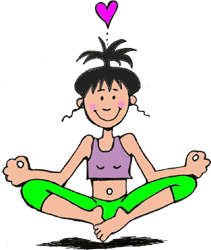The Hatha Yoga Pradipika tells us
“Success comes to him who is engaged in the practice. How can one get success without practice; for by merely reading books on yoga, one can never get success.” [I-67].
Swami Swatmarama, the fourteenth-century sage who wrote the Hatha Yoga Pradipika [1] might well add today ‘or by reading a web page’. Still for many people a book or a web page may be their only means to learn a yoga practice. And so our journey down the Yin River reveals to us some guidance for the practice of Yin Yoga.

Yogini by Violette
Please Note! Before embarking on this practice please make sure you are able to do so. Check with your doctor or health care professional before starting any yoga practice. The guidance given in this book is not meant to replace medical advice, and should be used only as a supplement if you are under the care of a health care professional. While care has been taken in compiling the guidance, we cannot take any responsibility for any adverse effects from your practice of yoga. When you are not sure of any aspect of the practice or feel unwell, seek medical advice. For more information on precautions before practicing yoga please check our Before You Practice page.
We will begin by looking at how to practice Yin Yoga, and then proceed to describe the postures (also called “asanas” or poses) most commonly used in the practice. There are not nearly as many asanas required in the yin style of yoga as are found in the more active practices. There are perhaps three dozen postures at most (excluding variations). The yin areas of the body generally targeted in the practice are between the knees and navel, the lower body. Since the poses are held longer, there are fewer poses that one can even attempt in one session, compared to the yang styles of yoga where one pose may be held for as little as five breaths. We will discover the most common poses and see them in detail, including their variations, options, and some contraindications. [2]
After viewing the most common asanas we will discover several flows; a flow is simply a linking together of asanas in a logical sequence. These flows have been created with a central theme or purpose in mind. Just as the asanas presented will not exhaust the possible poses one can do in Yin Yoga, the flows will be even less exhaustive. [3]
The last section on practice will concern the moving of energy. Suggestions will be offered on various movements, breathing patterns, and meditations designed to affect and stimulate the flow of energy (Chi or prana) in the body.
You can go directly to any one of these sections of the journey by clicking the link below:
Finally, as Swami Swatmarama warns us,
“Success cannot be attained by adopting a particular dress. It cannot be gained by telling tales. Practice alone is the means to success. This is true, there is no doubt.” [1-68]
The Swami must have been looking ahead 600 years and saw the modern desire for matching yoga outfits and coordinated colored mats. How one looks is certainly not the key to success. Said another way, this time by Pattabhi Jois,
“Practice! All is coming.”
- — Which means ‘Light on Yoga’
- — Contraindications are indications of when not to attempt a specific pose
- — In the www.YinYoga.com Yin Yoga Kula Web page other teachers and students will be offering their own favorite poses and flows – you may wish to check there for more on these topics. Or you can add your favorite ones
(Next: How to Practice Yin Yoga )
